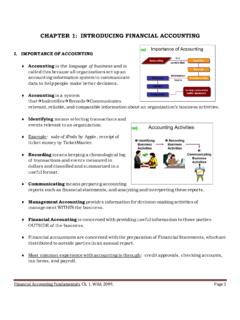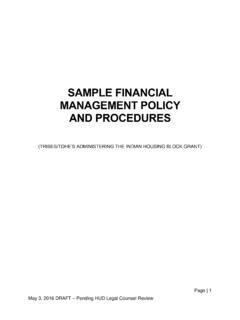Transcription of Financial Management
1 Preface Financial Management is an essential part of the economic and non economic activities which leads to decide the efficient procurement and utilization of finance with profitable manner. In the olden days the subject Financial Management was a part of accountancy with the traditional approaches. Now a days it has been enlarged with innovative and multi dimensional functions in the field of business with the effect of industrialization, Financial Management has become a vital part of the business concern and they are concentrating more in the field of Financial Management .
2 Financial Management also developed as corporate finance, business finance, Financial economics, Financial mathematics and Financial engineering. Understanding the basic concept about the Financial Management becomes an essential part for the students of economics, commerce and Management . This book provides detailed information about the finance and finance related area with simple language and the concepts are explained with easy examples. This book is also prepared based on the , , , , and syllabus of various universities for the benefits of the students.
3 AUTHORS. Contents Preface (v). CHAPTER - 1 INTRODUCTION TO Financial Management 1 10. Introduction 1. Meaning of Finance 1. Definition of Finance 1. Definition of Business Finance 2. Types of Finance 2. Definition of Financial Management 3. Scope of Financial Management 4. Objectives of Financial Management 5. Profit maximization 5. Favourable arguments for profit maximization 6. Unfavorable arguments for profit maximization 6. Drawbacks of profit maximization 6. Wealth maximization 6. Favourable arguments for wealth maximization 7.
4 Unfavourable arguments for wealth maximization 7. Approaches to Financial Management 7. Traditional approach 8. Functions of Finance Manager 8. Importance of Financial Management 9. Financial planning 9. Acquisition of funds 9. Proper use of funds 10. Financial decision 10. Improve profitability 10. Contents Increase the value of the firm 10. Promoting savings 10. Model Questions 10. CHAPTER - 2 Financial STATEMENT ANALYSIS 11 24. Introduction 11. Meaning and Definition 11. Income statement 12. Position statement 12. Statement of changes in owners equity 12.
5 Statement of changes in Financial position 12. Types of Financial Statement Analysis 13. Techniques of Financial Statement Analysis 14. Comparative statement analysis 15. Comparative balance-sheet analysis 15. Comparative profit and loss account analysis 16. Trend analysis 17. Common size analysis 17. Funds Flow Statement 18. Cash Flow Statement 19. Difference between funds flow and cash flow statement 19. Ratio Analysis 20. Liquidity ratio 21. Activity ratio 21. Solvency ratio 22. Profitability ratio 22. Model Questions 24.
6 CHAPTER - 3 SOURCES OF FINANCING 25 39. Introduction 25. Long-term Financial requirements or Fixed capital requirement 25. Short-term Financial requirements or Working capital requirement 25. Sources of Finance 26. Security Finance 28. Characters of security finance 28. Types of security finance 28. Ownership securities 28. Equity Shares 28. Features of equity shares 28. Advantages of equity shares 29. Disadvantages of equity shares 30. Preference Shares 30. Irredeemable preference shares 31. Contents Participating preference shares 31.
7 Non-participating preference shares 31. Convertible preference shares 31. Non-convertible preference shares 31. Features of preference shares 31. Advantages of preference shares 31. Disadvantages of preference shares 32. Deferred Shares 32. No Par Shares 32. Creditorship securities 33. Debentures 33. Types of debentures 33. Features of debentures 34. Advantages of debenture 34. Disadvantages of debenture 34. Internal Finance 35. Depreciation funds 35. Retained earnings 35. Advantages of retained earnings 36. Disadvantages of retained earnings 36.
8 Loan Financing 37. Financial institutions 37. Commercial banks 37. Short-term loans 38. Development banks 38. Model Questions 38. CHAPTER - 4 CAPITALIZATION 41 45. Introduction 41. Meaning of Capital 41. Fixed capital 41. Definition of fixed capital 41. Character of fixed capital 42. Working capital 42. Capitalization 42. Meaning of capitalization 42. Definition of capitalization 43. Types of Capitalization 43. Over capitalization 43. Causes of over capitalization 43. Effects of over capitalization 44. Remedies for over capitalization 44.
9 Under capitalization 44. Causes of under capitalization 44. Contents Effects of under capitalization 45. Remedies of under capitalization 45. Watered capitalization 45. Causes of watered capital 45. CHAPTER - 5 CAPITAL STRUCTURE 47 64. Introduction 47. Meaning of capital structure 47. Definition of capital structure 47. Financial Structure 48. Optimum Capital Structure 49. Objectives of capital structure 49. Forms of capital structure 49. Factors Determining Capital Structure 50. Leverage 50. Cost of capital 50. Capital Structure Theories 50.
10 Traditional approach 51. Assumptions 51. Comments 53. Net Income (NI) approach 53. Net Operating Income (NOI) approach 55. Modigliani and Miller approach 58. Model Questions 64. CHAPTER - 6 COST OF CAPITAL 65 82. Introduction 65. Meaning of cost of capital 65. Definitions 65. Assumption of cost of capital 66. Classification of Cost of Capital 66. Explicit and implicit cost 66. Average and marginal cost 67. Historical and future cost 67. Specific and combine cost 67. Importance of Cost of Capital 67. Importance to capital budgeting decision 67.





